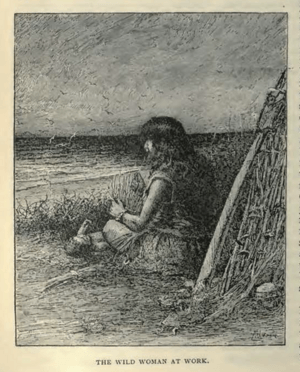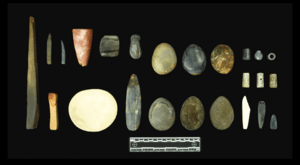Nicoleño facts for kids
 |
|
| Total population | |
|---|---|
| 200 – 300 (1800, est.) | |
| Regions with significant populations | |
| Languages | |
| Nicoleño language | |
| Religion | |
| Catholicism, traditional religion | |
| Related ethnic groups | |
| Chumash, Tongva, Cupeño, Cahuilla, Luiseño, Acjachemen |
The Nicoleño were a group of people who lived on San Nicolas Island in California a long time ago. They spoke a unique Uto-Aztecan language. Their population faced a terrible event around 1811 due to sea otter hunters. The last known member of their community was a woman named Juana Maria, who was born before 1811 and passed away in 1853. Her story is very famous.
Contents
Who Were the Nicoleño?
Archaeological findings show that San Nicolas Island, like the other Channel Islands, has been home to people for at least 10,000 years. The Nicoleño people were likely related to those living on Santa Catalina and San Clemente Island. These groups were part of the Takic branch of the Uto-Aztecan people. They were also connected to the Tongva people, who lived in what is now Los Angeles County. The name Nicoleño was given to them by a scholar named Alfred L. Kroeber. The Chumash called them the Niminocotch. We do not know what they called themselves.
Early Encounters with Europeans
The expedition led by Juan Rodríguez Cabrillo saw San Nicolas Island in 1543. However, they did not land or write much about the people living there. In 1602, the Spanish explorer Sebastián Vizcaíno visited the island. He gave it the name it still has today. Not much is known about the Nicoleño from this time until the early 1800s. By then, their population had already decreased. This was partly because Spanish missionaries moved people from other Channel Islands to the mainland.
A Difficult Time for the Nicoleño
Around 1814, a ship from the Russian–American Company brought Aleut and Russian fur traders to San Nicolas Island. They were hunting for sea otters and seals. During this time, the Nicoleño community suffered greatly due to conflicts with these hunters. Their population was severely reduced. By the 1830s, only about twenty Nicoleño people remained. Some reports even say there were as few as seven, including six women and an elderly man named Black Hawk. Black Hawk had been injured during the earlier events.
The Story of Juana Maria
When people on the mainland heard about the few remaining Nicoleño, Santa Barbara Mission organized a rescue. In late 1835, Captain Charles Hubbard sailed to the Channel Islands on a ship called Peor es Nada. Most of the remaining Nicoleño boarded the ship. However, one woman, who later became known as Juana Maria, did not arrive before a storm forced the ship to leave. Captain Hubbard could not return for her right away. His ship later sank in the San Francisco Bay. Because no other ships were available, further rescue attempts were delayed.
Many of the Nicoleño who were rescued went to live at the Mission San Gabriel Arcángel. Sadly, they were not immune to the diseases they found there. Black Hawk became blind and later drowned. It seems the others also passed away by the time Juana Maria was found. She was rescued in early September 1853. After several failed attempts to find her, Captain George Nidever finally located her. He brought her to the mainland. No one could understand her language. She was cared for by Nidever and his wife. However, she became sick with dysentery and died seven weeks after her arrival.
Learning About the Nicoleño
Most of what we know about the Nicoleño comes from Juana Maria. When Captain Nidever found her, she was living in a round shelter made of brush. It was about 1.8 meters (6 feet) wide and 1.5 meters (5 feet) tall. It had a small opening on one side. She cooked her food over a fire inside her home. Other similar shelters were still standing then. Another type of home was made with brush walls supported by whale ribs. Juana Maria hung seal meat from poles around her home. Like other native Californians, the Nicoleño were skilled at weaving baskets. Juana Maria was described as making four different shapes. When she was found, she wore a dress made of cormorant bird skins, decorated with feathers. She also had many items made from animal sinew and bone.
Discoveries on the Island
The first archaeological visit to San Nicolas Island was in 1875 by Paul Schumacher for the Smithsonian Institution. His team found many artifacts on the surface. These items were likely from a later period of Nicoleño culture. The island's climate does not preserve older items well. Early visitors collected items like grass mats, clothing pieces, bone knives, and fishhooks. They also found soapstone carvings of fish and birds. The Nicoleño people relied entirely on the ocean for food. The island had only four types of land animals, none good for eating. But the ocean around the island had many fish, sea mammals, and birds. The Nicoleño were very good at catching them.
In 1939, Arthur Woodward documented the remains of a whalebone structure. This structure was thought to belong to the Lone Woman (Juana Maria). In 2009, archaeologists found two Nicoleño redwood boxes eroding from a sea cliff. A whale rib marked their location. These boxes and other items were carefully recovered. Inside, they found about 200 artifacts. These included Nicoleño, Euro-American, and Native Alaskan materials. The items suggest the boxes date from 1815 to 1853. They might have been used by Juana Maria. In 2012, a U.S. Navy archaeologist reported finding a site that could have been Juana Maria's cave.
Over the years, many human remains and burial objects have been found on San Nicolas Island. Leaders from the Pechanga Band of Luiseño Mission Indians visited the island. This tribe claims a cultural connection with the Nicoleño. They were concerned about how the remains were being handled. With the Navy's approval, they established a cultural claim. This means they now help care for the human remains and burial artifacts.
Their Language
The Nicoleño people spoke the Nicoleño language. Sadly, this language is now extinct.
Images for kids
-
Juana Maria, the last surviving member of the Nicoleño people




